Chang Cheng
Author: Walter Obert
Publisher: Tenkigames / Hutter Trade
Year: 2007
review by

| x |
|
|
|
|
|
|
|
|
|
|
|
|
|
|
|
|
|
|
|
|
|
|
|
|
|
|
|
|
|
|
|
|
|
|
|
|
|
|
|
|
|
|
|
|
|
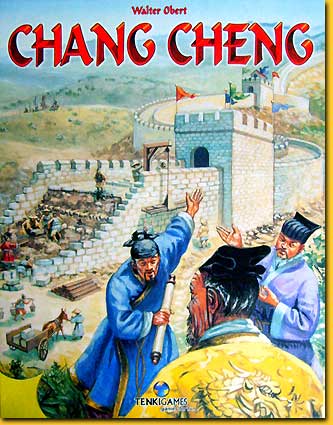 |
|
Northern China is under constant attack of the Barbaric hordes. Of course the Emperor of China doesn’t sit idle: he orders his men to build an enormous defensive wall, the Great Wall of China. We are in charge of the execution of this prestigious project. But China is a large country, and not every province is equally valuable! The players that manage to protect the richest and most prosperous provinces will be rewarded with many prestige points, while it is less beneficial for their reputation if the Mongols manage to invade their provinces despite their efforts on the Great Wall. |
| x |
|
|
|
|
|
|
|
|
|
|
|
|
|
|
|
|
|
|
|
|
|
|
|
|
|
|
|
|
|
|
|
|
|
|
|
|
|
|
|
|
|
|
|
|
|
| The board is composed of four parts that can be joined together to form an extremely large construction site for the Great Wall. North of the wall we see the Mongol provinces, and south of the wall is Northern China. At the beginning of the game only two boards are placed on the table; the remaining two boards are added on later in the game. Each Chinese province has a fixed value of 3 to 6 points, and to keep he game variable, one random reputation counter (value 0 to 4) is placed in each province. In the Mongol provinces one random face-down threat counter with a value of –2 to –4 is placed; this symbolises the strength of the Mongol army in that province. |
| x |
|
|
|
|
|
|
|
|
|
|
|
|
|
|
|
|
|
|
|
|
|
|
|
|
|
|
|
|
|
|
|
|
|
|
|
|
|
|
|
|
|
|
|
|
|
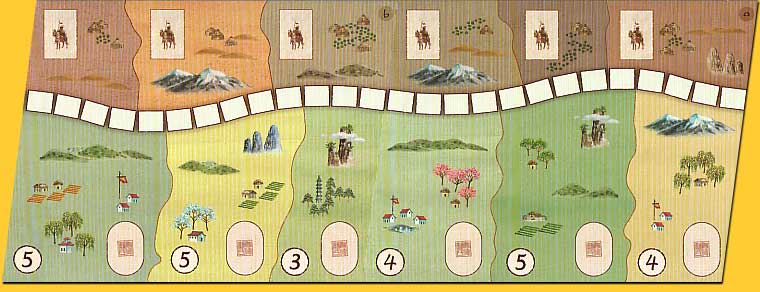 |
| x |
|
|
|
|
|
|
|
|
|
|
|
|
|
|
|
|
|
|
|
|
|
|
|
|
|
|
|
|
|
|
|
|
|
|
|
|
|
|
|
|
|
|
|
|
|
|
Each player receives 14 wall blocks, one double wall block, one tower block and six action cards in his colour. A player can choose between the following actions:
- place two wall blocks in two different Chinese provinces
- place two action cards in two different Chinese provinces
- place one wall block and one action card in one Chinese province
- place the double wall block or the tower block
|
| x |
|
|
|
|
|
|
|
|
|
|
|
|
|
|
|
|
|
|
|
|
|
|
|
|
|
|
|
|
|
|
|
|
|
|
|
|
|
|
|
|
|
|
|
|
|
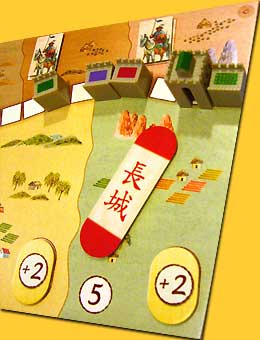 |
|
After placing a wall block, the player may look at the face-down threat counter in the Mongol province adjacent to his wall block, so he will know how strong the Mongol army in that province is. This is important for the Mongol invasion that takes place at the end of the game. As soon as the wall in a Chinese province, which is always composed of 3 to 6 building spaces, is completely finished, that province will be scored. First, all action cards that have been played in the province are turned over. There are six different action cards with priority 1 to 6. The card with the lowest number is resolved first. If there are more cards with the same priority number, they cancel each other out and are removed. |
| x |
|
|
|
|
|
|
|
|
|
|
|
|
|
|
|
|
|
|
|
|
|
|
|
|
|
|
|
|
|
|
|
|
|
|
|
|
|
|
|
|
|
|
|
|
|
| Examples of the actions are destroying an opponent’s wall block, exchange two wall blocks, or remove an unresolved action card from the province. There is also an action card that counts as two additional wall blocks, and one that adds or subtracts two points from the value of the province. When all action cards are resolved, they are removed from the game. The player that has the majority of wall blocks in the province gets the total value of the province: the fixed value plus the value of the reputation counter. When three provinces have been scored, the third part of the board is added to the game, and after another three scorings, the last part is also added. |
|
|
| x |
|
|
|
|
|
|
|
|
|
|
|
|
|
|
|
|
|
|
|
|
|
|
|
|
|
|
|
|
|
|
|
|
|
|
|
|
|
|
|
|
|
|
|
|
|
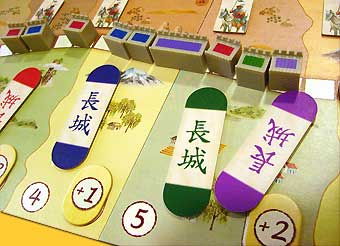 |
x |
The game is over as soon as the Great Wall is finished and all provinces have been scored. And then, as to test the strength of our new wall, the Mongols invade! The face-down threat counters are revealed, and the minus points will be subtracted from the score of the player that has the majority of wall blocks in the Mongol province, and can thus be held responsible for the fiasco. The tower block protects the players from these penalty points. The player that has the most reputation points left after the attack has been resolved in all provinces, wins the game. |
| x |
|
|
|
|
|
|
|
|
|
|
|
|
|
|
|
|
|
|
|
|
|
|
|
|
|
|
|
|
|
|
|
|
|
|
|
|
|
|
|
|
|
|
|
|
|
| x |
|
|
|
|
|
|
|
|
|
|
|
|
|
|
|
|
|
|
|
|
|
|
|
|
|
|
|
|
|
|
|
|
|
|
|
|
|
|
|
|
|
|
|
|
|
| x |
|
|
|
|
|
|
|
|
|
|
|
|
|
|
|
|
|
|
|
|
|
|
|
|
|
|
|
|
|
|
|
|
|
|
|
|
|
|
|
|
|
|
|
|
|
 |
|
|
|
|
|
|
|
|
|
|
|
|
|
|
|
|
|
|
|
|
|
|
|
|
|
|
|
|
|
|
|
|
|
|
|
|
|
|
|
|
|
| On its own, Chang Cheng is a good game. Because the Chinese and Mongol provinces don’t overlap completely, it is possible to get the majority, and the points, in the Chinese province, but no majority, and no penalty points, in the Mongol provinces on the other side (although it has been demonstrated that the other way around is also possible... this, however, has not proven to be a winning strategy). Introducing the game boards into the game gradually prevents that players place their wall blocks so far apart that for the majority of the game, there is no scoring whatsoever, and all the provinces are filled up only in the last couple of rounds of the game. A good solution to this potential problem. |
|
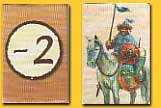 |
| x |
|
|
|
|
|
|
|
|
|
|
|
|
|
|
|
|
|
|
|
|
|
|
|
|
|
|
|
|
|
|
|
|
|
|
|
|
|
|
|
|
|
|
|
|
|
 |
|
The board consists of four parts, each printed on both sides, that can be used in random order; this results in quite a number of different situations. Also good or the variability of the game are the reputation counters. These counters add 0 to 4 points to the fixed value of the Chinese provinces, which is always equal to the number of wall block building sites. The disadvantage of the counters is that small provinces with high reputation counters become as valuable as large provinces with low reputation counters, while the latter require more wall blocks and therefore more effort to claim! This gives you the idea that it doesn’t really matter what you do.
This feeling is aggravated by the threat counters in the Mongol provinces; they have values between –2 and –4, not a shocking difference. It doesn’t pay off to select some Chinese provinces that you want, and some Mongol provinces that you absolutely don’t want, because it doesn’t really matter all that much. |
| x |
|
|
|
|
|
|
|
|
|
|
|
|
|
|
|
|
|
|
|
|
|
|
|
|
|
|
|
|
|
|
|
|
|
|
|
|
|
|
|
|
|
|
|
|
|
Chang Cheng works fine, the material and the rulebook in five languages look good, and when the Great Wall starts to take shape on the board, it is a beautiful sight. But what it all comes down to is that it’s a majority game, and there are already quite a lot of those on the market. What gives Cheng Chang some added value, however, are the action cards. They add extra possibilities, tactical options and some bluff to the game.
© 2008 Barbara van Vugt
|
| x |
|
|
|
|
|
|
|
|
|
|
|
|
|
|
|
|
|
|
|
|
|
|
|
|
|
|
|
|
|
|
|
|
|
|
|
|
|
|
|
|
|
|
|
|
|
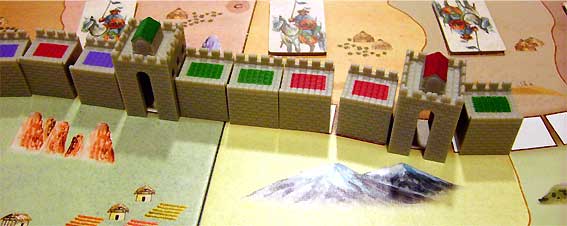 |
| x |
|
|
|
|
|
|
|
|
|
|
|
|
|
|
|
|
|
|
|
|
|
|
|
|
|
|
|
|
|
|
|
|
|
|
|
|
|
|
|
|
|
|
|
|
|
Chang Cheng, Walter Obert, Tenkigames / Hutter Trade, 2007 - 2 to 4 players, 12 years and up, 60 minutes
|
  |
|
|
|
|
|
|
|
|
|
|
|
|
|
|
|
|
|
|
|
|
|
|
|
|
|
|
|
|
|
|
|
|
|
|
|
|
|
|
|
|
|
  |
|
|
|
|
|
|
|
|
|
|
|
|
|
|
|
|
|
|
|
|
|
|
|
|
|
|
|
|
|
|
|
|
|
|
|
|
|
|
|
|
|
  |
|
|
|
|
|
|
|
|
|
|
|
|
|
|
|
|
|
|
|
|
|
|
|
|
|
|
|
|
|
|
|
|
|
|
|
|
|
|
|
|
|
  |
|
|
|
|
|
|
|
|
|
|
|
|
|
|
|
|
|
|
|
|
|
|
|
|
|
|
|
|
|
|
|
|
|
|
|
|
|
|
|
|
|
  |
|
|
|
|
|
|
|
|
|
|
|
|
|
|
|
|
|
|
|
|
|
|
|
|
|
|
|
|
|
|
|
|
|
|
|
|
|
|
|
|
|
| x |
|
|
|
|
|
|
|
|
|
|
|
|
|
|
|
|
|
|
|
|
|
|
|
|
|
|
|
|
|
|
|
|
|
|
|
|
|
|
|
|
|
|
|
|
|
| x |
|
|
|
|
|
|
|
|
|
|
|
|
|
|
|
|
|
|
|
|
|
|
|
|
|
|
|
|
|
|
|
|
|
|
|
|
|
|
|
|
|
|
|
|
|
 |
|
|
|
|
|
|
|
|
|
|
|
|
|
|
|
|
|
|
|
|
|
|
|
|
|
|
|
|
|
|
|
|
|
|
|
|
|
|
|
|
|
 |
|
|
|
|
|
|
|
|
|
|
|
|
|
|
|
|
|
|
|
|
|
|
|
|
|
|
|
|
|
|
|
|
|
|
|
|
|
|
|
|
|
| x |
|
|
|
|
|
|
|
|
|
|
|
|
|
|
|
|
|
|
|
|
|
|
|
|
|
|
|
|
|
|
|
|
|
|
|
|
|
|
|
|
|
|
|
|
|
 |
|
|
|
|
|
|
|
|
|
|
|
|
|
|
|
|
|
|
|
|
|
|
|
|
|
|
|
|
|
|
|
|
|
 |
|
|
|
|
|
|
|
|
|
|
|
|
|
|
|
|
|
|
|
|
|
|
|
|
|
|
|
|
|
|
|
|
|
|
|